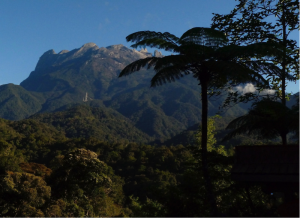Text & Photographs by Dr. Robert L. Fleming
“Kinabalu can be rightly considered the botanical crown jewel of Borneo, but no short paper can even superficially cover all the gems.”

Mt Kinabalu, 4095m (13,435 ft) as viewed from near the Kinabalu Park headquarters at 1524m (5000ft)
Stars dimmed as people gathered in the dark on the summit of Mt Kinabalu to quietly await the dawn. If one has climbed the last 600 meters by flashlight, ascending ladders, and guided over the granite slabs by a pale rope that doubled as a handhold, the sunrise can be quite emotional. Those of us who reached the top early could see the dots of scattered flashlights moving slowly upwards. By the time the fluffy clouds below us glowed an orange-pink, a hundred or so people had gathered on Kinabalu’s 4095m, 13,435ft summit.
Mount Kinabalu is the highest peak in Borneo at 743 km2 (287mi2). Its summit is part of a batholith– a huge granite dome that formed deep within the earth’s crust. Then, some ten million years ago, tectonic activity forced the granite up through overlying sandstone and shale. Now, thousands of years later, these sedimentary layers have eroded away to leave a stunning granitic peak, which is among the youngest stand-alone, non-volcanic mountains in the world. And one that is still rising at an average rate of about 5mm a year with growth spurts often occurring during earthquakes, such as the 6.0 magnitude quake in 2015.

In recognition of the mountain’s topography and astonishing natural history the state government of Sabah created the 754km2, 291mi2 Kinabalu National Park in 1964, the first national park in Malaysia. In addition, Kinabalu was honored as a World Heritage Site in 2000.
After sunrise and as the sun’s rays started to glint off the feldspar crystals in the granite, I was among the last to depart. And slowly picking my way down, I could see that some of the smooth gray slabs showed grooves of comparatively recent glaciation.
Soon the sight of a small, red-flowered bush poking up from a crevice stopped me. Upon examination this turned out to be Rhododendron ericoides, a plant with narrow, heather-like leaves. It is one of 26 species of ‘southern’ rhododendrons (Vireyas) that grow on this mountain. These plants thrive on Kinabalu as well as at higher elevations east to New Guinea and together form part of the flora of Wallacea, a botanical transition zone between Asia and Australia.

The Rhododendron ericoides (pictured left) was growing at a height of 3350m (11000ft) in a crack where soil had accumulated between glacier-smoothed granite slabs. The thousand or so species of rhododendrons are now divided in to eight subgenera including sections growing in Malesia.
Current distributions of plants and animals speak of plate movements and climate change, among other factors. During the recent ice age, low-lying portions of southeastern continental Asia, now called the Sunda Shelf, were mostly covered by Asian tropical rainforest which harbored, among others, clouded leopards, elephants, orangutans and ‘flying’ snakes (Chrysopelea). But with the ending of the last ice age and the rising of ocean levels, those forests now survive only on elevated tracts that include the rim of Southeast Asia, the Malay Peninsula, Borneo, Sumatra and other nearby islands.
After examining the diminutive rhododendron, I continued descending the mountain, passing rock faces edged by ravines where accumulations of soil had given rise to additional plant life. Kinabalu is washed by rain, especially during the November-January winter monsoon, when water cascades off the upper dome, forming a drapery of white strands distinctly contrasting with the wet, dark rocks. Some particles eroding from the granite collect in gullies and crevices and these, augmented by wind-blown debris from lower elevations, afford footholds high on the mountain for a few hardy plants such as the white-flowered Leptospermum and a Vaccinium with hanging, bell-shaped flowers.

At about 3,100m (10,000ft) the hiking trail to the summit passes these somewhat gnarled and stunted Dacridiyum and Leptospermun trees growing in serpentinzed soils over ultrabasic rocks. Serpentine soils contain low levels of nitrogen and calcium along with high amounts of magnesium, these often combined with heavy metals such as chromium, cobalt, and nickel. Sizeable concentrations of heavy metals can be toxic to most plants, but species, including the trees seen here as well as some pitcher plants and tropical lady slipper orchids have adapted to serpentine substrates so can survive here. Much of the exposed rock of upper Kinabalu is granite but about 16% of the park’s surface area is composed of ultrabasic formations.
Dropping down 760m (2500ft) from the summit to Panar Labuan is an exercise not only for the knees but also for botanical minds. Looking down and southwest from Labuan, one’s eye descends over an unbroken forest canopy with no openings visible until it reaches the buildings of the park headquarters complex. This canopy may be unbroken, but it is not unvaried, as a mosaic of greens, grays and faint yellows speak of different tree communities that compose the forest. However, with some 5000 species of vascular plants listed for the park, the visible trees form only a small part of the plant diversity – underneath lies a plethora of plants, about a fifth of which are orchids.
Cartographers divide the planet’s surface into sections, using latitudinal lines and longitude markers. Biologists, on the other hand, paint the planet into eco-regions or biological bands, these usually identified by floral features that are in turn dictated by genetics, climate, and other factors. The biological tropics, for example, located on both sides of the equator, could be colored green. And then as one moves progressively toward the colder poles, other colors would indicate different botanical compositions, until one reaches the ice and rocks of the Antarctic or the pebble-strewn flats of the high arctic. In addition, as one would expect within such broad swaths, a host of local color variations occur, influenced by altitude, moisture regimes, wind currents, and underlying geology, among others.

This image is from the Danum Valley, some c 170km southeast of Kinabalu. Multilevel, tropical rain forest covers some 35% of the lower elevations of Kinabalu and harbors an amazing array of vertebrates that can glide (often called ‘flying’) including a Rhacophorus frog with large, webbed feet, Draco a ‘flying’ lizard, Chrysopelia a flying snake, the Galeopterus Colago (distantly related to Primates), and flying squirrels (14 species in Borneo). Why are there so many gliding creatures in these forests? One thought is that multiple-height rainforest trees, many of them Dipterocarps, have promoted a gliding adaptation in different animals.
Much of the tropical rainforest that was once widespread over lowland Sabah has now been logged or replaced by towns and cultivations with oil palm plantations covering vast stretches. However, large pockets of rainforest do remain, especially towards the hilly center of the island and there are strenuous efforts to sustainably manage this asset. A major endeavor here is the Heart of Borneo Initiative, a trilateral effort initiated by the World Wildlife Fund and signed in 2007 by the governments of Brunei, Indonesia and Malaysia with the goal of protecting this 200,000km2 rainforest through thoughtful and long-term management. Kinabalu is part of this effort.
Forest covers 95% of the Kinabalu park, and of this about 40% is tropical rainforest, a type which prevails at low elevations in areas where lack of roads reduced colonization before the park was formed. Kinabalu’s tropical forest is characterized by a multi-layered tree canopy that includes forty species of Dipterocarps, some of which reach 50m (164ft) in height and tower over most others trees. Fruit from these trees, especially figs, are a dietary mainstay of the park’s orangutans. At ground level, plants that can tolerate shade thrive. These include many species of wild ginger, bamboos, palms, including a climbing rattan, as well as two species of that foul-smelling Rafflesia.
Besides tropical rainforest, four other major biological bands appear in succession as one climbs into ever-cooler air. These include the subtropical (‘nearly tropical’) zone followed by the warm temperate, cold temperate, and ending with alpine-like mountain tundra conditions towards the top of the mountain. Botanical transitions from one zone to the next are not sudden but here on Kinabalu, as on all mountain slopes, these divisions are comparatively close together. Thus when driving up the surfaced road from Kota Kinabalu to the park headquarters, one can transition in just 30 minutes from lowland species to fine subtropical forest at park headquarters. Here, at 1585m, 5200ft, one finds the buildings surrounded by beautiful tree ferns. Ferns in general proliferate in the comparatively cooler air of the subtropical and warm temperate zones.

The world’s largest pitcher plant, Nepenthes rajah (pictured above) is found only on the serpentine substrate of Kinabalu and nearby Mt. Tamguyukon. This remarkable variety of species has adapted to lessen the effects of the toxins present in the surrounding serpentine rocks, so these plants can survive under otherwise deadly conditions. Tropical pitcher plants, Nepenthes, are mostly found at elevated (cool) zones within tropical latitudes and occur from New Caledonia north to India and southwest to Madagascar.
In addition to the usual biological divisions attributed to temperature (altitude), 16% of Kinabalu’s surface exhibits serpentines– rocks derived from ultrabasic or mafic formations, which are often rich in heavy metals such as nickel, cobalt, and chromium. While these chemicals are toxic to many plants, some species have evolved to limit the absorption of toxins into their tissues, especially into their reproductive parts, and hence flourish where other plants die.
From about 2000m to 2800m, the hiking trail to the summit crosses a fine band of this serpentine and here the vegetation is very specialized with gnarled forms of Leptospermum and Dacrydium dominant. Other serpentine adapted plants are some 120 species of orchids and 16 species of Nepenthes, carnivorous pitcher plants. Among the serpentine adapted orchids and pitcher plants, the exceedingly rare Rothchild’s Lady Slipper, Paphiopedilum rotshchildianum, as well as the magnificent pitcher plant, Nepenthes rajah, are not seen from the hiking trail.

Orangutans (Pongo) were once widespread in Southeast Asia but today live only on Borneo and Sumatra. Except for females with young, orangutans are usually solitary animals. On occasion, though, several adults may gather in a particularly large tree, often a fig, when the fruit is at its prime. Orangutans are usually arboreal but do descend to the ground where they walk on hind feet and the knuckles of their hands. This male orangutan (pictured above), living in the Danum Valley to the southeast of Kinabalu, was on the ground selecting choice stems of wild ginger plants for a mid-morning meal.
Kinabalu is an amazing place with astonishing vegetation but there are many other aspects that may draw one’s attention away from plants, including a hollow, whooping sound echoing through the forest canopy. The sound we heard is a territorial marker of a Bornean Gibbon, and likely says that ‘we are here’ (they live in small family parties). Kinabalu hosts over 100 species of mammals, most of which live in the lowland forests where many inhabit the forest canopy. These include bats, flying squirrels (12 species in Borneo), gibbons and leaf monkeys (langurs). Orangutans also spend most of their time in trees, but they do come to the ground to feed on succulent plant stems. Others species, such as the Bearded Pigs, are strictly terrestrial.
As one moves uphill, the number of mammal species lessens, but there are a number of squirrels and tree shrews in the montane forests. Kinabalu is especially rich in squirrel types, with twenty-eight species recorded here. The enigmatic tree shrews are a group of mammals restricted to South and SE Asia. These small creatures look somewhat like squirrels but have long, pointed snoots and comparatively thin tails. Many are largely arboreal and all have a high brain to body mass ratio. Due to skeletal features and some organ systems, these mammals are often placed close to primates. Tree shrews are quite vocal, with variable, chattering calls that convey different meanings including alarm and defense.
Birds, on the other hand are kings of the daytime sound. They make Kinabalu’s forests come alive with songs, chirps, cheeps, tweets, and clucks. Borneo hosts over 600 bird species and Kinabalu alone lists over 300, of which the Golden-naped Barbet and 29 others species live only on the island while others, such as rare Whitehead’s Trogon and Whitehead’s Spiderhunter, are found only on this mountain.

The Golden-naped Barbet, Psilopogon pulcherrimus, is one of 26 species of Asian barbets. These birds live in tropical or subtropical areas, primarily in forests, where they depend on a year-around supply of fruit, especially figs. Older trees enable these birds to excavate their nest cavities in the aging wood. The extensive forest cover of Kinabalu National Park provides both these requirements and hence the loud repetitive notes of barbets are a distinct part of Kinabalu’s sound patterns. This barbet was feeding on Debregeasia berries at 1830m (6,000ft) on Kinabalu.
In contrast to the lower altitudes, time-constrained birders almost never visit the upper elevations around Labuan. Why? Because upper Kinabalu is home to only two species of birds: the endemic Friendly Warbler, a small, brown bird with a loud voice, and the wide-ranging Island Thrush. Birding is a fast growing activity in Malaysia as well as in other countries, and world wide people traveling to see birds is becoming an increasingly important part of the ecotourism business.
Flying over Sabah and watching rows and rows of oil palms pass beneath the plane’s wings it is easy to become depressed. However focusing on conservation successes is good and there are many successes here in Sabah, including Kinabalu.
When the Kinabalu Park was established in 1964, the mountain was already sacred to the local people so the upper elevations were not much visited, and at that time the boundaries were carefully drawn to exclude villages and cultivations from the park. This top-down initiative worked well in the initial set up, but over time the management of the Kinabalu Park has evolved.
 In recent decades, many places around the world have shown that long-term conservation is most successful where locals see an advantage, particularly an economic advantage, to the conservation effort and are thus motivated to protect this resource. And with the founding of the Mountain Guides Association in 2011, and the establishment of a PPPP (park-public-private-people) model, Kinabalu has evolved into a pattern that gives local communities more meaningful participation in the park. Yet still more needs to be done. For example, in some parks, such as the Sagarmatha National Park in Nepal, a substantial portion of the park entry fees is allocated to neighboring communities for projects that are annually determined by local committees.
In recent decades, many places around the world have shown that long-term conservation is most successful where locals see an advantage, particularly an economic advantage, to the conservation effort and are thus motivated to protect this resource. And with the founding of the Mountain Guides Association in 2011, and the establishment of a PPPP (park-public-private-people) model, Kinabalu has evolved into a pattern that gives local communities more meaningful participation in the park. Yet still more needs to be done. For example, in some parks, such as the Sagarmatha National Park in Nepal, a substantial portion of the park entry fees is allocated to neighboring communities for projects that are annually determined by local committees.
A growing world wide community now recognizes the uniqueness of Kinabalu and my hope is that Kinabalu will long remain a jewel in the crown of Borneo’s natural world.
_________________________________
Many thanks to Professor Fleming for another superb contribution to the University blog! For more on our Professor of Natural History , visit our Faculty Directory.

Dr. Fleming (pictured right) and Michael, a Dunsun-Kadasan guide. Visitors may hike the trails round headquarters on their own but for a climb to the summit of Kinabalu, a guide is required. People speaking the Kadasan-Dunsun language were among the early settlers in Sabah and about half of the people of the state derive from this linguistic group. Kadasan-Dunsun farms and villages surround Mt Kinabalu and the park provides supplemental incomes for about a thousand people who are employed full time or part time as staff, guides or porters.




One thought on “Mt. Kinabalu: A Borneo Gem”
What an excellent article but also what beautiful pictures! We are locals and proud of the work we are doing to protect our precious environment, so it is always pleasing to read blog posts like this and see just how the locals are working to further highlight the wildlife and environmental needs. Really pleasing to read and I am very jealous of the pictures indeed!